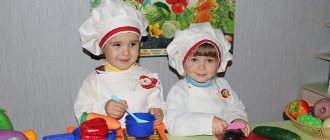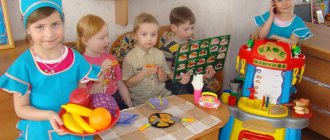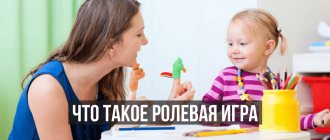"Polyclinic"
Program content: To arouse children's interest in the medical profession. Develop the ability to creatively develop the plot of the game. Fix the names of medical instruments: phonendoscope, syringe, spatula. To cultivate a sensitive, attentive attitude towards the patient, kindness, responsiveness, and a culture of communication. Vocabulary work: phonendoscope, spatula, grafting, vitamins. Game material: doctor’s coat and cap, nurses’ coats and caps, medical instruments (thermometer, syringe, spatula), bandage, brilliant green, cotton wool, mustard plasters, patient cards, vitamins. Preliminary work: Excursion to the medical office. Observing the work of a doctor. Reading fiction: J. Rainis “The Doll Got Sick”, V. Berestov “The Sick Doll”. A. Barto “Tamara and I”, P. Obraztsov “Treating a Doll”, A. Kardashova “Our Doctor”. Dramatization “The Animals Are Sick.” Review of the album “We are playing “doctor”. Making attributes for the game. Conversations with children “We are being treated by a doctor and a nurse”, “How should we behave in a doctor’s office?” Playing roles: Doctor, nurse, patient. They act out the following stories: “At the doctor’s appointment”, “The doctor called home” “I hurt my finger” “I have a sore throat” “Giving an injection” “Getting a vaccination” Game actions: The doctor receives patients, listens carefully to their complaints, asks questions, listens, looks at the throat , makes an appointment. The nurse gives injections, gives medicine, vitamins, puts mustard plasters, lubricates wounds, bandages. The patient comes to see the doctor, tells what worries him, and follows the doctor’s recommendations.
"Family"
Program content: To consolidate children's ideas about the family and the responsibilities of family members. Develop interest in the game. Teach children to assign roles and act according to the role they assume, to develop the plot. Encourage children to creatively reproduce family life through play. Learn to act in imaginary situations, use various objects - substitutes. Foster love and respect for family members and their work. Playing material: Furniture, dishes, attributes for equipping a house, “kindergarten”, large construction set, toy car, baby doll, toy stroller, bags, various substitute items. Preliminary work: Conversations: “My family”, “How do I help my mother”, “Who works for whom?” “What do we do at home?” Examination of plot pictures, photographs on the topic. Reading fiction: N. Zabila “Yasochka’s kindergarten”, A. Barto “Mashenka”, B. Zakhoder “Builders”, “Driver”, D. Gabe from the series “My Family”: “Mom”, “Brother”, “Work” ", E. Yanikovskaya "I go to kindergarten", A. Kardashova "The Big Wash". Playing roles: mother, father, grandmother, grandfather, eldest daughter, preschool children, doll - baby. The following scenes are played out: “Morning in the family” “Lunch in the family” “Construction site” “Dad is a good owner” “We have a baby in our family” “Evening in the family” “Mom puts the children to bed” “Day off in the family” “In the family” a child is sick" "We help mom wash clothes" "Big cleaning of the house" "We have guests" "Moving to a new apartment" "Family holiday: mother's day, New Year, birthday" Game actions: Mom-teacher gets ready and goes to work; prepares everything necessary for activities with children; accepts children and works with them; plays, walks, draws, teaches, etc.; gives children to parents, cleans the workplace; returns home from work; relaxes, communicates with her children and husband; helps grandma, puts the children to bed. A housewife mother gathers and escorts her daughter to kindergarten and her husband to work; takes care of the youngest child (doll), walks with him, cleans the house, prepares food; meets a child from kindergarten, a husband from work; feeds them, communicates, puts the children to bed. A construction worker dad gets ready for work, takes his child to kindergarten, goes to work; builds houses, bridges; returns from work, picks up the child from kindergarten, returns home; helps his wife around the house, plays with the children, communicates. The father-driver gets ready for work, takes the child to kindergarten, goes to work; delivers loads (bricks) to the construction site, unloads them, goes for new ones; picks up the child from kindergarten and returns home; helps his wife around the house; invites neighbors over for tea; sees off neighbors; communicates with children, plays with them, puts them to bed. Grandmother gathers and escorts her grandchildren to kindergarten and school; cleans the house; turns to her eldest granddaughter for help; picks up her granddaughter from kindergarten and asks the teacher about her behavior; cooks dinner, bakes a pie; asks family members how the work day was; offers to invite neighbors to tea (dinner), treats everyone to a pie; plays with grandchildren; gives advices. Grandfather helps grandma, dad, reads newspapers, magazines; plays with grandchildren, communicates with neighbors. The eldest daughter helps her grandmother prepare food, wash dishes, clean the house, iron clothes; plays and walks with his younger sister, communicates. Preschool children get up, get ready and go to kindergarten; in kindergarten they do: play, draw, walk; return from kindergarten, play, help parents, go to bed.
"Kindergarten"
Program content: Expand children's understanding of the content of labor actions of kindergarten employees. Induce in children a desire to imitate the actions of adults. Cultivate friendly relationships in games between children. Game material: Dolls with a set of clothes, furniture, dishes, small toys, mops, buckets, rags, aprons, bathrobes, washing machine, basin, drying rack, ironing board, irons, stove, cookware set, food, vacuum cleaner, musical instruments. Preliminary work: Observation of the work of the teacher, assistant teacher. Conversation with children about the work of a teacher, assistant teacher, cook, nurse and other kindergarten workers. Excursion-inspection of the music (physical education) hall, followed by a conversation about the work of muses. manager (physical supervisor). Excursion-inspection of medical. office, observation of the doctor’s work, conversations from the personal experiences of children. Inspection of the kitchen, conversation about technical equipment that makes the work of kitchen workers easier. Game-dramatization based on N. Zabila’s poem “Yasochkin’s kindergarten” using toys. Excursion to the laundry. Organization of children's work - washing doll clothes, handkerchiefs. Playing roles: Doctor, nurse, teacher, music worker, physical education director, nanny, cook, laundress. The scenes are played out: “Morning reception” “Our classes” “Exercise in kindergarten” “Nanny’s work - breakfast” “Nanny’s work - cleaning the group” “On a walk” “At a music lesson” “At a physical education lesson” “Doctor’s examination” “Lunch” in a kindergarten" "The work of a cook in a kindergarten" "Work in the laundry of a kindergarten" Play activities: The teacher receives children, talks with parents, plays with children, conducts classes. Physical instructor conducts morning exercises and physical education. The junior teacher keeps order in the group, assists the teacher in preparing for classes, receives food... Music. the leader conducts music. class. The doctor examines the children, listens, and makes prescriptions. The nurse measures temperature, height, weighs, gives vaccinations, checks the cleanliness of groups and kitchens. The cook prepares food and gives it to the teacher's assistants. The laundress washes the clothes, dries them, irons them, folds them neatly, and gives them clean clothes to the nanny.
"I am a driver"
Program content: Expand children's understanding of the profession of a driver and auto mechanic. Develop the ability to build role-playing dialogue, use role-playing speech, creativity in the game, using real objects to create a game environment. Cultivate goodwill and willingness to help. Foster a culture of behavior in transport. Vocabulary words: gas station, gasoline, canister, tanker, conductor, mechanic, baton, inspector, license. Game material: tools for repairing cars, a gas pump, building material, a steering wheel, a canister, a hose for simulating filling a car with gasoline, a bucket with a rag, tickets, money, a bag for the conductor, a traffic light, a baton, a traffic police inspector’s cap, driver’s documents (licenses) . Preliminary work: Excursion to the bus stop, observation of the bus, taxi and driver’s work. Introduce simple regulatory gestures: “stop”, “get ready”, “passage is allowed”. Outdoor games: “Pedestrians and Taxi”, “Traffic Light”. Reading and looking at illustrations on the topic “Chauffeurs”. D/i “Attentive driver”, “Recognize the car”, “Repair the car”. Reading: V. Suteev “Different Wheels”, 3. Alexandrova “Truck”, A. Kardashov “Rain Car” E. Motkovskaya “I am a Car” B. Stepanov “Chauffeur”, “Bus Driver”, B. Zhitkov “Traffic Light” N. Kalinina “How the guys crossed the street”, N. Pavlova “By car”. Game roles: Taxi driver, bus driver, conductor, passengers, truck driver, mechanic, gas station attendant, policeman (traffic police inspector). The following plots are played out: “Building a bus” “Learning to drive a bus” “The bus carries passengers” “Car repair” “Fueling the car” “Car washing” “A truck is carrying furniture to a new house” “A truck is carrying cargo (bricks, sand, snow)” “A grocery car carries food (to a store, to a kindergarten, to a hospital)” “I’m taking passengers to the station” “I’ll go to the garage” “We’re going to kindergarten” “We’re driving around the city” “We’re going to visit” “A trip to the country” Game actions: The taxi driver delivers passengers to their destination, takes money for travel, takes care of passengers, helps with luggage. A truck driver loads and unloads cargo. The bus driver drives the bus, turns the steering wheel, gives a signal, troubleshoots problems, makes stops, and announces them. The conductor sells tickets, checks travel tickets, keeps order inside the bus, and answers passengers' questions about where it is most convenient for them to get off. Passengers board the bus, buy tickets, get off at stops, give up their seats to elders and passengers with children, help them get off the bus, follow the rules of behavior on public transport, communicate; preparing for a long trip - packing things, water, food for the trip; they dress up and comb their hair if they go on a visit or to the theater. The mechanic carries out repair work, checks the condition of the car before the trip, washes the car with a hose - wipes it. The gas station attendant inserts the hose, pours in gasoline, and takes the money. Policeman (traffic police inspector) - regulates traffic, checks documents, monitors compliance with traffic rules.
"Salon"
Program content: To introduce the specifics of the work of male and female hairdressers. To form children’s understanding of how women care for their nails. To teach them to perform several sequential actions aimed at fulfilling their duties. Develop the ability to engage in role interaction and build role dialogue. Foster a culture of communication with “clients” Vocabulary words: master, hair dryer, apron, cape, razor, manicure. Game material: Mirror, bedside table for storing attributes, various combs, bottles, curlers, hairspray, scissors, hair dryer, cape, apron for hairdresser, manicurists, cleaners, hairpins, elastic bands, bows, towel, magazines with hairstyle samples, razor, hair clipper, towels, money, mop, buckets, dust cloths, for the floor, nail polish, nail file, cream jars. Preliminary work: Conversation “Why do we need hairdressers.” Ethical conversation about the culture of behavior in public places. Reading stories by B. Zhitkov “What I saw”, S. Mikhalkov “In the hairdresser”. Excursion to the hairdresser. Consideration of items necessary for the work of a hairdresser. Didactic games “Beautiful hairstyles for dolls”, “Let’s learn how to tie bows”, “Pick a bow for a doll”, “Miracle hairdryer”. Consider shaving items. Making game attributes with children (aprons, capes, towels, nail files, checks, money, etc.). Making the album “Hairstyle Models”. Game roles: Hairdressers - ladies' master and men's hairdresser, manicurist, cleaning lady, clients (visitors): mothers, fathers, their children. The following plots are played out: “Mom takes her daughter to the hairdresser” “Dad takes his son to the hairdresser” “Let’s give the dolls beautiful hairstyles” “We’re going by bus to the hairdresser” “Getting our hair done for the holiday” “Let’s get ourselves in order” “In the men’s room” “Shopping for goods” for a hairdressing salon" "We invite a hairdresser to a kindergarten" Game activities: The hairdresser in the women's room puts a cape on the client, dyes hair, washes his hair, towels off, cuts, shakes off the cut strands from the cape, wraps it in curlers, blow-dries the hair, varnishes it, braids braids, pins hairpins, gives recommendations on hair care. The barber of the men's salon shaves, washes the hair, blow-dries hair, makes haircuts, combs the clients' hair, shapes the beard and mustache, offers to look in the mirror, refreshes with cologne. The manicurist files the nails, paints them with varnish, and applies cream to the hands. Clients greet politely while waiting in line - look at albums with illustrations of different hairstyles, read magazines, can drink coffee in a cafe; asking for a haircut or manicure; they consult, pay money, thank you for your services. The cleaning lady sweeps, dusts, washes the floor, and changes used towels.



